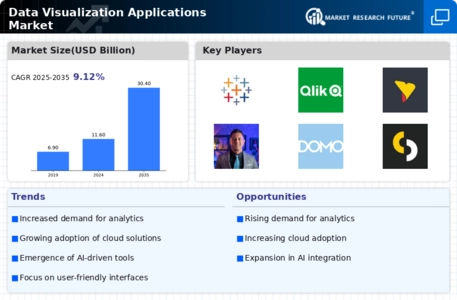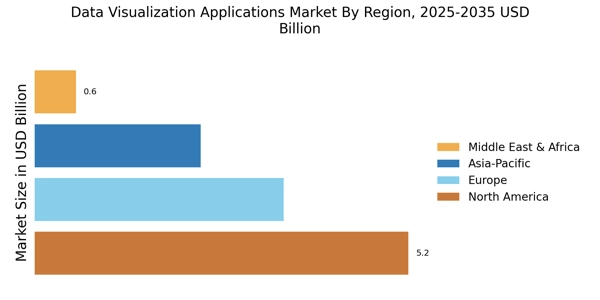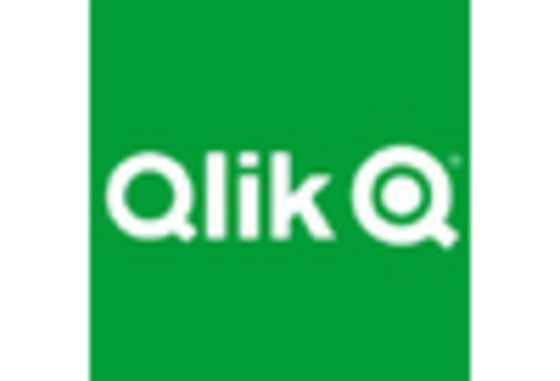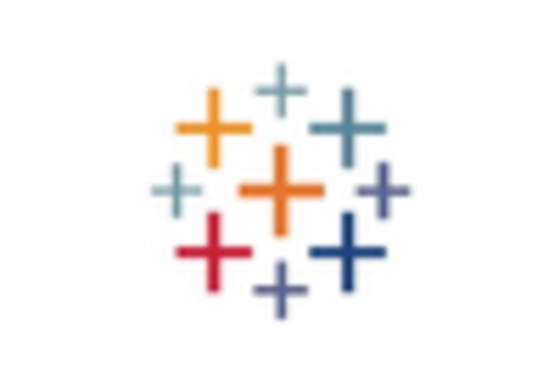The Data Visualization Applications Market is currently characterized by a dynamic competitive landscape, driven by the increasing demand for data-driven decision-making across various sectors. Key players such as Tableau (US), Microsoft (US), and Qlik (US) are at the forefront, leveraging innovative technologies and strategic partnerships to enhance their market positions. Tableau (US) focuses on user-friendly interfaces and advanced analytics capabilities, while Microsoft (US) integrates its Power BI with Azure services, promoting a seamless data ecosystem. Qlik (US) emphasizes its associative analytics engine, which allows users to explore data freely, thus catering to a diverse clientele. Collectively, these strategies foster a competitive environment that prioritizes innovation and customer-centric solutions.
In terms of business tactics, companies are increasingly localizing their operations and optimizing supply chains to enhance responsiveness to market demands. The Data Visualization Applications Market appears moderately fragmented, with numerous players vying for market share. However, the influence of major companies is substantial, as they set industry standards and drive technological advancements. This competitive structure encourages smaller firms to innovate rapidly, thereby contributing to a vibrant market ecosystem.
In August 2025, Tableau (US) announced a strategic partnership with Salesforce (US) to enhance its data visualization capabilities within the Salesforce ecosystem. This collaboration is poised to provide users with more integrated analytics solutions, thereby expanding Tableau's reach and reinforcing its position in the market. The partnership signifies a shift towards more collaborative approaches in data visualization, allowing for richer insights and improved user experiences.
In September 2025, Microsoft (US) unveiled a new feature in Power BI that utilizes artificial intelligence to automate data preparation processes. This development is particularly significant as it streamlines workflows for users, enabling them to focus on analysis rather than data wrangling. By integrating AI into its offerings, Microsoft not only enhances its product appeal but also positions itself as a leader in the AI-driven analytics space, which is increasingly becoming a competitive differentiator.
In July 2025, Qlik (US) launched a new initiative aimed at promoting sustainability through data visualization. This initiative encourages organizations to leverage data to track and reduce their carbon footprints. By aligning its offerings with sustainability goals, Qlik (US) not only addresses a growing market demand but also enhances its brand reputation as a socially responsible company. This strategic move reflects a broader trend within the industry, where companies are increasingly expected to contribute to environmental sustainability.
As of October 2025, the competitive trends in the Data Visualization Applications Market are heavily influenced by digitalization, sustainability, and the integration of artificial intelligence. Strategic alliances are becoming more prevalent, as companies recognize the value of collaboration in enhancing their technological capabilities. Looking ahead, competitive differentiation is likely to evolve from traditional price-based strategies to a focus on innovation, advanced technology, and reliable supply chains. This shift underscores the importance of adaptability and forward-thinking in maintaining a competitive edge in an ever-evolving market.


















Leave a Comment